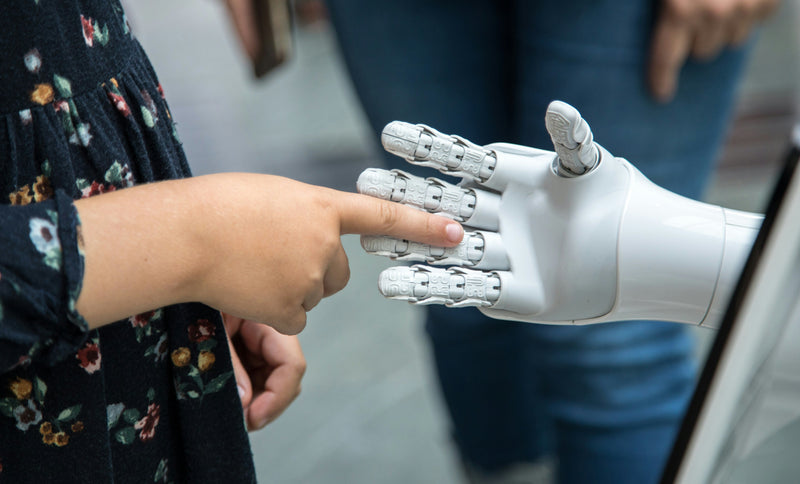
Little Engineers, Big Dreams: How Children Can Learn Responsibly from Our Robot Friends 🤖✨
Picture this: Your six-year-old is building with blocks when they suddenly stop and ask, "Mom, do robots have feelings like me?" It's one of those moments that makes you pause—part wonder, part worry about how to navigate this brave new world where artificial intelligence and robotics are becoming part of our children's everyday reality. How do we help them embrace the exciting possibilities while developing wisdom about technology's role in their lives? 🧱💭
Why Robot Learning Matters for Today's Children 🌟🚀
We're raising the first generation of children who will grow up alongside increasingly sophisticated robots and AI systems. Rather than shying away from this reality, we can help our children develop healthy, thoughtful relationships with technology that serve them throughout their lives.
When children learn about robots responsibly, they gain remarkable benefits:
- They develop critical thinking skills about technology and its limitations 🧠🔍
- They learn problem-solving approaches inspired by engineering and programming 🛠️💡
- They understand the importance of human creativity and emotional intelligence 🎨❤️
- They build awareness of ethical decision-making in technology use 🤝⚖️
- They prepare for future careers that will likely involve human-robot collaboration 👨💻🤖
The Curiosity Mindset Journal nurtures the investigative mindset children need to explore technology thoughtfully and ask important questions about how robots work and their impact on our world. 🔍✨
What Healthy Robot Learning Looks Like (And What It Doesn't) 👀🔍
Before diving deeper, let's clarify what responsible robot learning actually looks like for young children:
Healthy robot learning IS:
- Understanding that robots are tools created by humans 🛠️👨🔬
- Recognizing what robots can and cannot do 📊🚫
- Appreciating both the benefits and potential concerns of robotics 🌈⚠️
- Maintaining curiosity about how things work 🧐🔧
- Developing empathy for how technology affects different people 👫🌍
Healthy robot learning IS NOT:
- Believing robots are magical or all-powerful ✨🚫
- Thinking robots can replace human relationships 🤗❌
- Becoming overly dependent on technology for basic tasks 📱🚫
- Losing appreciation for human creativity and problem-solving 🎨🧠
- Accepting technology without questioning its purpose or impact 🤔❓
The engaging animal characters in the My Furry Soulmates series model the kind of thoughtful questioning and problem-solving that helps children approach new concepts—including technology—with both excitement and wisdom. 📚🦊
The Building Blocks: Age-Appropriate Robot Concepts 🧱🌱
Robot learning for young children should focus on fundamental concepts that build understanding gradually:
1. Robots as Problem-Solving Tools 🛠️
Help children understand that robots are created to solve specific problems:
- Vacuum robots help keep floors clean 🏠
- Medical robots help doctors perform precise surgeries 🏥
- Factory robots help make products safely and efficiently 🏭
- Exploration robots help scientists study places too dangerous for humans 🚀
Children love discovering how each robot is designed for its specific job, just like different tools in a toolbox!
2. The Human Behind the Machine 👨💻
Every robot starts with human creativity, planning, and problem-solving:
- People decide what problems need solving 💭
- Engineers design robots to address those problems ⚙️
- Programmers write instructions (code) to tell robots what to do 💻
- Humans test and improve robots to make them better 🔧
This understanding helps children appreciate human ingenuity and see themselves as potential creators, not just consumers of technology.
3. Input, Processing, and Output 🔄
Children can grasp the basic concept that robots:
- Receive information from their environment (sensors) 👁️👂
- Process that information using their "brain" (computer) 🧠
- Take action based on their programming (motors, speakers) 🤖
The Confident Mindset Journal helps children develop the confidence to explore complex concepts like these step by step, building understanding without feeling overwhelmed. 📔✨
4. Collaboration, Not Competition 🤝
Rather than viewing robots as replacements for humans, children can learn about human-robot collaboration:
- Doctors work with robots to help patients heal 👩⚕️🤖
- Artists use robots to create new kinds of sculptures 🎨🤖
- Scientists partner with robots to explore space 👨🚀🛰️
- Teachers might use robots to help explain difficult concepts 👩🏫📚
Responsible Robot Exploration: What Children Can Safely Learn 🌟🛡️
There are wonderful ways children can explore robotics that build understanding while maintaining safety and age-appropriateness:
Hands-On Building Activities 🧩
Simple robotics kits designed for children allow them to:
- Build basic robots using blocks or simple components 🏗️
- Program simple movements using visual coding 💻
- Understand cause and effect in robot behavior 🔄
- Experience the trial-and-error process of engineering 🔧
Observation and Discussion 👁️
Encourage children to notice robots in their daily lives:
- Automatic doors at stores 🚪
- Self-checkout machines (with adult supervision) 🛒
- Voice assistants in homes (with clear boundaries) 🏠
- Robotic toys that respond to commands 🎮
STEM Learning Through Robot Concepts 🔬
Robot learning naturally incorporates multiple subjects:
- Science: How sensors detect light, sound, or movement 🔬
- Technology: Basic programming concepts and digital literacy 💻
- Engineering: Design thinking and problem-solving processes ⚙️
- Math: Patterns, sequences, and logical thinking 🔢
The Curiosity Mindset Journal provides structured ways for children to explore these STEM connections through guided reflection and investigation. 🔍✨
Important Conversations: Ethics and Responsibility 🗣️⚖️
Age-appropriate discussions about robot ethics help children develop important critical thinking skills:
Kindness and Respect 💕
Even though robots don't have feelings, we can model kindness:
- Treating robot toys gently teaches care for belongings 🧸
- Using polite language with voice assistants models good communication 🗣️
- Understanding that real kindness is reserved for living beings 🌱
Privacy and Safety 🔒
Simple concepts children can understand:
- Some information should stay private (like home addresses) 🏠
- Adults should always supervise interactions with internet-connected devices 👨👩👧👦
- Not all robots or technology have our best interests in mind 🤔
Human Uniqueness 🌟
Help children appreciate what makes humans special:
- Our ability to feel emotions and form relationships ❤️
- Our creativity and ability to imagine new possibilities 🎨
- Our capacity for empathy and moral reasoning 🤗
- Our ability to make choices based on values, not just programming ⚖️
The Kindness Mindset Journal helps children develop the empathy and ethical thinking that will serve them well as they navigate an increasingly technological world. 📔💕
Potential Pitfalls: What to Watch Out For 🚩⚠️
While robot learning offers wonderful opportunities, there are some common concerns to address:
Over-Dependence 📱
Ensure children still develop basic skills without technological assistance:
- Physical play and outdoor exploration 🏃♀️🌳
- Face-to-face social interaction 👥
- Creative problem-solving without digital tools 🎨
- Basic math and reading skills 📚
Unrealistic Expectations 🌙
Help children understand current robot limitations:
- Robots can't think or feel like humans 🧠❤️
- They sometimes make mistakes or break down 🔧
- They can only do what they're programmed to do 💻
- They can't replace human judgment in complex situations 🤔
Screen Time Balance ⚖️
Robot learning shouldn't become another excuse for excessive screen time:
- Prioritize hands-on building and exploration 🧩
- Balance digital activities with physical play 🏃♀️
- Ensure technology enhances rather than replaces real-world learning 🌍
Practical Robot Learning Activities for Families 🏠🛠️
Want to explore robot concepts responsibly with your children? Try these engaging approaches:
Robot Scavenger Hunt 🔍
Find robots and automated systems around your home and community, discussing how each one helps people.
Build a "Robot" from Recycled Materials ♻️
Use cardboard boxes, bottles, and craft supplies to create pretend robots, encouraging creativity and understanding of robot components.
Movement Games 🕺
Play "robot" games where children give each other simple commands, helping them understand programming concepts.
Story Creation 📚
Make up stories about helpful robots, discussing what problems they solve and how they work with humans.
Question Journaling 📝
Use the Curious Mindset Journal to help children explore their questions about robots and technology thoughtfully.
The Future Mindset: Preparing Children for Tomorrow 🌍🔮
When we help children learn about robots responsibly, we're preparing them for a future where human-technology collaboration will be commonplace:
- Problem-solving confidence: Understanding how robots work builds confidence in approaching complex challenges 💪🧩
- Ethical reasoning: Early exposure to technology ethics prepares them for future decision-making 🤔⚖️
- Creative thinking: Seeing robots as tools for human creativity rather than replacements for it 🎨💡
- Career readiness: Familiarity with technology concepts opens doors to future opportunities 💼🚀
- Digital citizenship: Understanding technology's impact on society builds responsible users 🌐🤝
By using tools like the Confident Mindset Journal, Curiosity Mindset Journal, Kindness Mindset Journal, and the thoughtful problem-solving modeled in the My Furry Soulmates series, we help children develop the balanced perspective they'll need to thrive in our technological future. 📚🧱
Starting Today: Simple Steps for Robot Learning 👣🌱
Introducing children to robot concepts doesn't require expensive equipment or technical expertise. Start with these accessible approaches:
- Notice and discuss automated systems you encounter together 🔍
- Ask "how do you think this works?" about simple machines and devices 💭
- Encourage building and creating with everyday materials 🧩
- Read books about inventors and engineers who create helpful technology 📚
- Practice giving clear, step-by-step instructions (like programming!) 📝
- Use journaling to explore questions about technology using the Curiosity Mindset Journal ✏️
Join Our Robot Learning Conversation! 💬❤️
How have you introduced robotics concepts to the children in your life? What questions have they asked that surprised you? Share your experiences in the comments below!
Remember: When we help children learn about robots responsibly during their early years, we're not just preparing them for a technological future—we're helping them develop the critical thinking, creativity, and ethical reasoning that will allow them to shape that future in positive ways. The goal isn't to create little technicians, but thoughtful humans who can work alongside technology to solve problems and create a better world for everyone. ✨🌟



0 comments